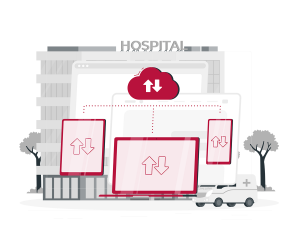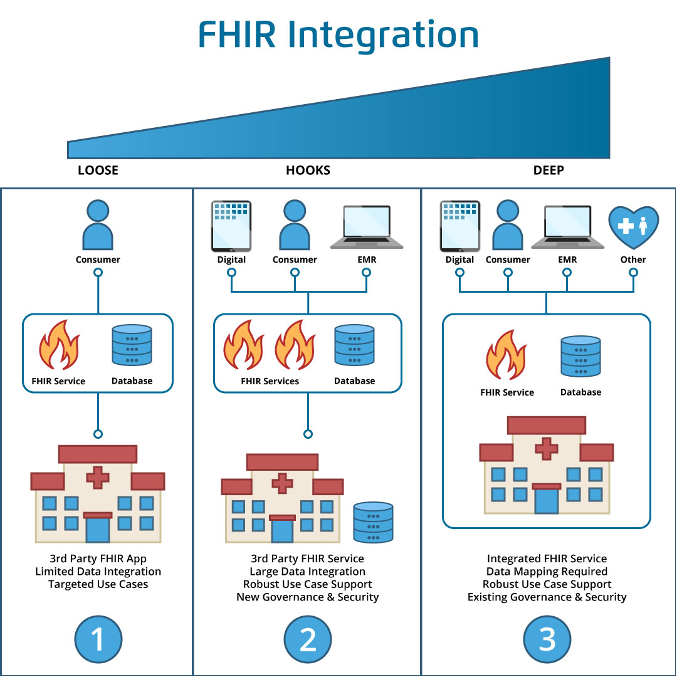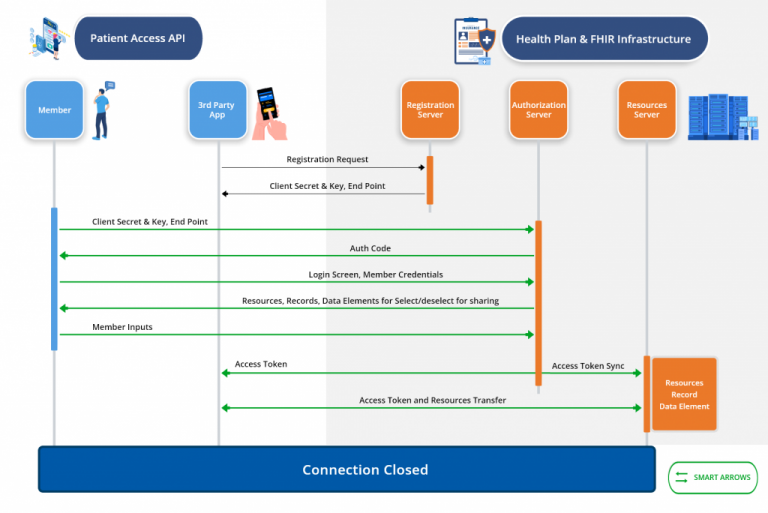
In the rapidly evolving world of healthcare, the effective use and exchange of electronic health records (EHRs) have become increasingly important for providing efficient, high-quality care. Key to this digital transformation is the adoption of standardized, open-source technologies that facilitate seamless communication and collaboration.
These innovations have the potential to significantly improve patient outcomes, streamline workflows across the healthcare industry, and improve interoperability and data sharing among diverse stakeholders, including patients, healthcare providers, and health systems.
In this article, Itirra, a leading Seattle-based healthcare software development company, will explore the two such groundbreaking technologies that are revolutionizing the way healthcare professionals access and share patient information: Fast Healthcare Interoperability Resources (FHIR) and Substitutable Medical Applications, Reusable Technologies on FHIR (SMART on FHIR).
What is FHIR?
FHIR, or Fast Healthcare Interoperability Resources, is a next-generation standard for the exchange of healthcare information developed by HL7 (Health Level Seven International), a not-for-profit organization dedicated to creating global standards for health data interoperability. FHIR aims to provide a comprehensive, flexible, and efficient framework for the seamless exchange of EHRs among healthcare providers, developers, and patients.
FHIR is built upon the concept of “resources,” which are modular, reusable, and granular components that represent different aspects of healthcare data, such as patients, practitioners, medications, diagnoses, and more. These resources can be easily combined, extended, and customized to represent complex healthcare scenarios and cater to specific use cases.
FHIR empowers healthcare organizations to share and access vital patient information easily and securely. By leveraging the power of FHIR, healthcare providers can enhance patient care, streamline workflows, and drive better health outcomes across the industry.
Some key features of FHIR include:
Simplicity
FHIR simplifies the process of sharing and consuming healthcare data through a straightforward, human-readable format based on XML and JSON. This enables easier integration and adoption by various stakeholders in the healthcare industry.
Scalability
FHIR is designed to be highly scalable, catering to small-scale implementations as well as large-scale, enterprise-level projects. Its modular approach allows for targeted data exchange, minimizing the need for extensive data mapping and transformations.
Interoperability
FHIR supports seamless data exchange between different healthcare systems, regardless of their underlying technologies or platforms. This is achieved through a standardized RESTful API that enables systems to communicate and share data easily.
Extensibility
FHIR is highly extensible, allowing for the creation of custom resources and profiles to meet unique healthcare requirements. This enables healthcare organizations to tailor the FHIR framework to their specific needs without compromising interoperability.
Security
FHIR incorporates robust security measures, such as support for OAuth2 and other authentication mechanisms, to ensure the privacy and protection of sensitive healthcare data.

What are the benefits of FHIR?
FHIR’s benefits enable a more connected, efficient, and patient-centric healthcare ecosystem, driving better health outcomes and empowering providers and patients alike, including:
Enhanced interoperability: FHIR promotes seamless communication between disparate healthcare systems, ensuring access to accurate patient data for better-informed clinical decisions and improved care.
Simplified integration: FHIR’s standardized API and modular design streamline the integration process, making it easier for developers to create applications that communicate with various healthcare systems, fostering innovation.
Increased data granularity: FHIR’s granular approach enables targeted data exchange, improving efficiency and ensuring only relevant information is shared.
Greater flexibility: FHIR’s extensibility allows healthcare organizations to adapt the standard to their unique needs without sacrificing interoperability, encouraging tailored solutions.
Faster adoption: FHIR’s compatibility with existing standards and its flexibility have contributed to rapid adoption across the industry, amplifying its potential for seamless data exchange and improved patient care.
What is SMART on FHIR?
SMART on FHIR, an acronym for Substitutable Medical Applications and Reusable Technologies on Fast Healthcare Interoperability Resources, is an innovative technology that combines the FHIR standard with a set of open specifications to create a seamless and secure app platform for healthcare. Developed by Boston Children’s Hospital and Harvard Medical School, SMART on FHIR aims to foster the development of interoperable, user-friendly applications that can be easily integrated into EHR systems, improving the experience for healthcare providers and patients alike.
The SMART on FHIR framework provides a standardized way for third-party applications to access and interact with healthcare data stored in EHRs. By leveraging the FHIR standard and its rich set of resources, SMART on FHIR applications can work seamlessly with multiple EHR systems, enabling healthcare providers to access a wide range of innovative tools and features without being locked into a specific vendor or platform.
SMART on FHIR bridges the gap between healthcare providers, EHR systems, and innovative applications. By harnessing the capabilities of FHIR and embracing an open, standardized approach, SMART on FHIR is poised to transform the healthcare landscape, enabling more efficient, personalized, and patient-centered care.
Key components of SMART on FHIR include:
App platform
SMART on FHIR defines a platform-agnostic specification for healthcare apps, enabling developers to create applications that work across different EHR systems and platforms without the need for custom integrations.
OAuth2 and OpenID Connect
SMART on FHIR utilizes OAuth2 and OpenID Connect to facilitate secure, granular access to healthcare data. These industry-standard protocols ensure that apps only access the data they are authorized to, safeguarding patient privacy and maintaining regulatory compliance.
EHR integration
SMART on FHIR apps can be easily embedded within EHR systems, allowing healthcare providers to access these tools and features directly from their EHR workflows. This integration simplifies the user experience and promotes more efficient use of healthcare data.
App ecosystem
The SMART on FHIR framework supports the development of an open, vibrant app ecosystem that encourages innovation and collaboration within the healthcare industry. Providers can choose from a wide range of applications that best suit their needs, while developers can create and distribute their apps with greater ease and reach.

What are the benefits of SMART on FHIR?
SMART on FHIR contributes to the development of a more efficient, personalized, and patient-centered healthcare environment, fostering innovation and driving improved patient care with open specifications, offering numerous advantages:
User experience: SMART on FHIR’s consistent user interface allows apps to integrate seamlessly into EHR systems, providing an intuitive experience for healthcare providers.
Platform-agnostic: The framework’s standardized specifications enable developers to create applications that work across different EHR systems and platforms without the need for custom integrations.
Secure data access: SMART on FHIR utilizes OAuth2 and OpenID Connect for secure, granular access to healthcare data, ensuring apps only access authorized data and maintain patient privacy.
EHR integration: SMART on FHIR enables seamless integration of third-party applications into EHR systems, allowing healthcare providers to access innovative tools and features directly from their workflows.
Enhanced patient engagement: The framework empowers patients to take an active role in their healthcare journey by facilitating access to and management of their health data from multiple sources.
Why is healthcare interoperability important?
FHIR and SMART on FHIR are pivotal in driving healthcare interoperability, a crucial factor in enhancing patient care, streamlining operations, and fostering innovation within the industry. By embracing these groundbreaking technologies, healthcare organizations can unlock the true potential of digital health and deliver better, more connected, and patient-centric care. Seamless, secure, and efficient exchange of health information is at the heart of this transformation, which offers numerous benefits for healthcare providers, patients, and the industry as a whole:
Improved patient care
Interoperability enables healthcare providers to access comprehensive, up-to-date patient information from various sources, resulting in more informed clinical decisions, personalized treatment plans, and better overall patient care. By integrating FHIR and SMART on FHIR technologies, providers can access a wealth of data that helps them understand the complete picture of a patient’s health, leading to more accurate diagnoses and targeted interventions.
Reduced healthcare costs
By facilitating the efficient exchange of health information, interoperability can help reduce the costs associated with redundant tests, delays in treatment, and other inefficiencies. FHIR and SMART on FHIR technologies enable healthcare organizations to optimize their resources, streamline processes, and minimize operational costs.
Enhanced patient engagement
Interoperability empowers patients to take a more active role in their healthcare journey. With FHIR and SMART on FHIR, patients can access and manage their health data from multiple sources, enabling them to better understand their health, engage with their care providers, and make more informed decisions about their treatment options.
Fostering innovation
Interoperability promotes an environment of innovation by encouraging the development of new applications, tools, and technologies that can be easily integrated into existing healthcare systems. The open, standardized approach of FHIR and SMART on FHIR facilitates the creation of a vibrant app ecosystem, driving the development of novel solutions that address critical healthcare challenges and improve patient outcomes.
Conclusion
By embracing FHIR and SMART on FHIR, healthcare organizations can create a more connected, efficient, and patient-centric ecosystem that drives better health outcomes and empowers providers and patients alike. The future of digital health is poised for significant advancements as these technologies continue to gain traction, reshaping the way healthcare providers access and share vital patient information. Now more than ever, it is crucial for healthcare organizations to invest in FHIR and SMART on FHIR to unlock their full potential and deliver the best possible care in an increasingly connected and data-driven world.
Our team of expert developers and healthcare professionals at Itirra is committed to harnessing the full potential of FHIR and SMART on FHIR to deliver innovative, secure, and interoperable solutions that cater to the unique needs of our clients. By partnering with Itirra, healthcare organizations can stay ahead of the curve, benefiting from the expertise and industry knowledge that comes from years of experience in developing state-of-the-art healthcare software.
As we continue to embrace and promote the adoption of FHIR and SMART on FHIR, Itirra remains dedicated to building a more connected, efficient, and patient-centric healthcare ecosystem. Together, we can drive better health outcomes, improve the patient experience, and pave the way for a brighter future in digital health.
